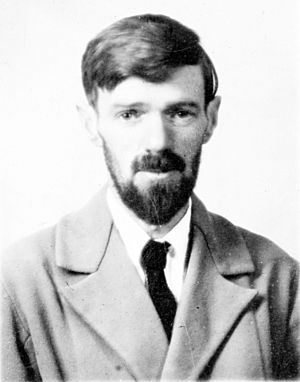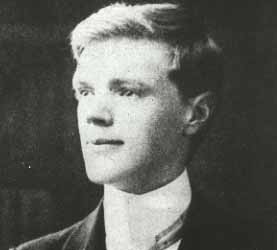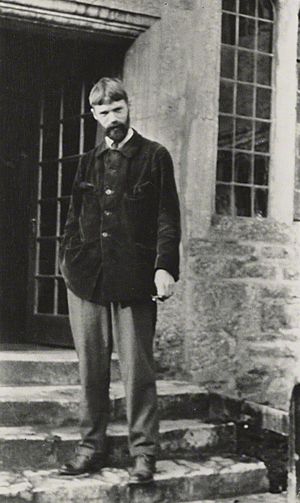D.H. Lawrence facts for kids
Quick facts for kids
D. H. Lawrence
|
|
|---|---|
 |
|
| Born | David Herbert Lawrence 11 September 1885 Eastwood, Nottinghamshire, England |
| Died | 2 March 1930 (aged 44) Vence, France |
| Resting place | D. H. Lawrence Ranch, Taos, New Mexico |
| Occupation | Novelist, poet |
| Nationality | British |
| Alma mater | University College Nottingham |
| Period | 1907–1930 |
| Genre | Modernism |
| Notable works |
|
David Herbert Lawrence (11 September 1885 – 2 March 1930) was an English writer and poet.
Contents
Life and career
Early life
The fourth child of Arthur John Lawrence, a barely literate miner at Brinsley Colliery, and Lydia Beardsall, a former pupil-teacher who had been forced to perform manual work in a lace factory due to her family's financial difficulties, Lawrence spent his formative years in the coal mining town of Eastwood, Nottinghamshire. The house in which he was born, 8a Victoria Street, is now the D. H. Lawrence Birthplace Museum. His working-class background and the tensions between his parents provided the raw material for a number of his early works. Lawrence roamed out from an early age in the patches of open, hilly country and remaining fragments of Sherwood Forest in Felley woods to the north of Eastwood, beginning a lifelong appreciation of the natural world, and he often wrote about "the country of my heart" as a setting for much of his fiction.
The young Lawrence attended Beauvale Board School (now renamed Greasley Beauvale D. H. Lawrence Primary School in his honour) from 1891 until 1898, becoming the first local pupil to win a county council scholarship to Nottingham High School in nearby Nottingham. He left in 1901, working for three months as a junior clerk at Haywood's surgical appliances factory, but a severe bout of pneumonia ended this career. During his convalescence he often visited Hagg's Farm, the home of the Chambers family, and began a friendship with Jessie Chambers, one of the daughters who would go on to inspire characters in his writing. An important aspect of this relationship with Chambers and other adolescent acquaintances was a shared love of books, an interest that lasted throughout Lawrence's life.
In the years 1902 to 1906 Lawrence served as a pupil-teacher at the British School, Eastwood. He went on to become a full-time student and received a teaching certificate from University College, Nottingham (then an external college of University of London), in 1908. During these early years he was working on his first poems, some short stories, and a draft of a novel, Laetitia, which was eventually to become The White Peacock. At the end of 1907 he won a short story competition in the Nottinghamshire Guardian, the first time that he had gained any wider recognition for his literary talents.
Early career
In the autumn of 1908, the newly qualified Lawrence left his childhood home for London. While teaching in Davidson Road School, Croydon, he continued writing. Jessie Chambers submitted some of Lawrence's early poetry to Ford Madox Ford (then known as Ford Hermann Hueffer), editor of the influential The English Review. Hueffer then commissioned the story Odour of Chrysanthemums which, when published in that magazine, encouraged Heinemann, a London publisher, to ask Lawrence for more work. His career as a professional author now began in earnest, although he taught for another year.
Shortly after the final proofs of his first published novel, The White Peacock, appeared in 1910, Lawrence's mother died of cancer. The young man was devastated, and he was to describe the next few months as his "sick year". Due to Lawrence's close relationship with his mother, his grief became a major turning point in his life.
In 1911, Lawrence was introduced to Edward Garnett, a publisher's reader, who acted as a mentor and became a valued friend, as did his son David.
In November 1911, abandoned teaching in order to become a full-time writer.
In March 1912, Lawrence met Frieda Weekley (née von Richthofen), with whom he was to share the rest of his life. Six years his senior, she was married to Ernest Weekley, his former modern languages professor at University College, Nottingham, and had three young children. However, she and Lawrence eloped and left England for Frieda's parents' home in Metz, a garrison town (then in Germany) near the disputed border with France. Lawrence experienced his first encounter with tensions between Germany and France when he was arrested and accused of being a British spy, before being released following an intervention from Frieda's father. After this incident, Lawrence left for a small hamlet to the south of Munich where he was joined by Frieda for their "honeymoon", later memorialised in the series of love poems titled Look! We Have Come Through (1917).
From Germany, they walked southwards across the Alps to Italy, a journey that was recorded in the first of his travel books, a collection of linked essays titled Twilight in Italy and the unfinished novel, Mr Noon.
Lawrence and Frieda returned to Britain in 1913 for a short visit. After the couple returned to Italy, staying in a cottage in Fiascherino on the Gulf of Spezia Lawrence wrote the first draft of what would later be transformed into two of his best-known novels, The Rainbow and Women in Love, in which unconventional female characters take centre stage. Both novels were highly controversial and were banned on publication in the UK.
Eventually, Frieda obtained her divorce from Ernest Weekley. Lawrence and Frieda returned to Britain shortly before the outbreak of World War I and were legally married on 13 July 1914.
Frieda's German parentage and Lawrence's open contempt for militarism caused them to be viewed with suspicion and live in near-destitution during wartime Britain.
In late 1917, after constant harassment by the armed forces and other authorities, Lawrence was forced to leave Cornwall at three days’ notice under the terms of the Defence of the Realm Act. This persecution was later described in an autobiographical chapter of his novel Kangaroo (1923). Lawrence spent a few months of early 1918 in the small, rural village of Hermitage near Newbury, Berkshire. Subsequently, he lived for just under a year (mid-1918 to early 1919) at Mountain Cottage, Middleton-by-Wirksworth, Derbyshire, where he wrote one of his most poetic short stories, “Wintry Peacock”. Until 1919, poverty compelled him to shift from address to address.
During this period, he barely survived a severe attack of influenza.
Exile
After the wartime years, Lawrence began what he termed his "savage pilgrimage", a time of voluntary exile from his native country. He escaped from Britain at the earliest practical opportunity and returned only twice for brief visits, spending the remainder of his life travelling with Frieda. This wanderlust took him to Australia, Italy, Ceylon (Sri Lanka), the United States, Mexico and the South of France. Abandoning Britain in November 1919, they headed south, first to the Abruzzo region in central Italy and then onwards to Capri and the Fontana Vecchia in Taormina, Sicily. From Sicily they made brief excursions to Sardinia, Monte Cassino, Malta, Northern Italy, Austria and Southern Germany.
Many of these places appear in Lawrence's writings.
Lawrence is often considered one of the finest travel writers in English. Sea and Sardinia describes a brief journey undertaken in January 1921 and focuses on the life of Sardinia’s people. Less well known is his eighty-four page introduction to Maurice Magnus's 1924 Memoirs of the Foreign Legion, in which Lawrence recalls his visit to the monastery of Monte Cassino.
Later life and career
In late February 1922, the Lawrences left Europe intending to migrate to the United States. They sailed in an easterly direction, however, first to Ceylon and then on to Australia. During a short residence in Darlington, Western Australia, Lawrence met local writer Mollie Skinner, with whom he coauthored the novel The Boy in the Bush. This stay was followed by a brief stop in the small coastal town of Thirroul, New South Wales, during which Lawrence completed Kangaroo, a novel about local fringe politics that also explored his wartime experiences in Cornwall.
While in the U.S., Lawrence rewrote and published Studies in Classic American Literature, a set of critical essays begun in 1917 and later described by Edmund Wilson as "one of the few first-rate books that have ever been written on the subject". In addition, Lawrence completed new fictional works, including The Boy in the Bush, The Plumed Serpent, St Mawr, The Woman who Rode Away, The Princess and other short stories. He also produced the collection of linked travel essays that became Mornings in Mexico.
A brief voyage to England at the end of 1923 was a failure and Lawrence soon returned to Taos, convinced his life as an author now lay in the United States. However, in March 1925 he suffered a near fatal attack of malaria and tuberculosis while on a third visit to Mexico. Although he eventually recovered, the diagnosis of his condition obliged him to return once again to Europe. He was dangerously ill and the poor health limited his ability to travel for the remainder of his life. The Lawrences made their home in a villa in Northern Italy, living near Florence.
The return to Italy allowed him to renew old friendships; during these years he was particularly close to Aldous Huxley, who was to edit the first collection of Lawrence's letters after his death, along with a memoir. After Lawrence visited local archaeological sites (particularly old tombs) with artist Earl Brewster in April 1927, his collected essays inspired by the excursions were published as Sketches of Etruscan Places, a book that contrasts the lively past with Benito Mussolini's fascism.
During his final years, Lawrence renewed his serious interest in oil painting. Official harassment persisted and an exhibition of his paintings at the Warren Gallery in London was raided by the police in mid 1929 and several works were confiscated.
Death
Lawrence continued to write despite his failing health. In his last months he wrote numerous poems, reviews and essays. His last significant work was a reflection on the Book of Revelation, Apocalypse. After being discharged from a sanatorium, he died on 2 March 1930 at the Villa Robermond in Vence, France, from complications of tuberculosis.
Written works
Short stories
Lawrence's best-known short stories include "The Captain's Doll", "The Fox", "The Ladybird", "Odour of Chrysanthemums", "The Princess", "The Rocking-Horse Winner", "St Mawr", and "The Woman who Rode Away". Among his most praised collections is The Prussian Officer and Other Stories, published in 1914. His collection The Woman Who Rode Away and Other Stories, published in 1928, develops the theme of leadership that Lawrence also explored in novels such as Kangaroo and The Plumed Serpent and the story Fanny and Annie.
Poetry
Lawrence wrote almost 800 poems, most of them relatively short. His first poems were written in 1904 and two of his poems, "Dreams Old" and "Dreams Nascent", were among his earliest published works in The English Review.
Just as the First World War dramatically changed the work of many of the poets who saw service in the trenches, Lawrence's own work dramatically changed, during his years in Cornwall. During this time, he wrote free verse influenced by Walt Whitman.
Lawrence rewrote some of his early poems when they were collected in 1928. This was in part to fictionalise them, but also to remove some of the artifice of his first works. His best-known poems are probably those dealing with nature such as those in the collection Birds, Beasts and Flowers, including the Tortoise poems and "Snake".
Two notebooks of Lawrence's unprinted verse were posthumously published. These contain two of Lawrence's most famous poems about death, "Bavarian Gentians" and "The Ship of Death".
Plays
Lawrence wrote A Collier's Friday Night about 1906–1909, though it was not published until 1939 and not performed until 1965. He wrote The Daughter-in-Law in 1913, though it was not staged until 1967, when it was well received. In 1911 he wrote The Widowing of Mrs. Holroyd, which he revised in 1914; it was staged in the US in 1916 and in the UK in 1920, in an amateur production. It was filmed in 1976; an adaptation was shown on television (BBC 2) in 1995. He also wrote Touch and Go towards the end of World War I, and his last play, David, in 1925.
Painting
D. H. Lawrence had a lifelong interest in painting, which became one of his main forms of expression in his last years. His paintings were exhibited at the Warren Gallery in London's Mayfair in 1929. Several artists and art experts praised the paintings. The largest collection of the paintings is now at La Fonda de Taos hotel in Taos, New Mexico. Several others, including Boccaccio Story and Resurrection, are at the Humanities Research Centre of the University of Texas at Austin.
See also
 In Spanish: D. H. Lawrence para niños
In Spanish: D. H. Lawrence para niños




